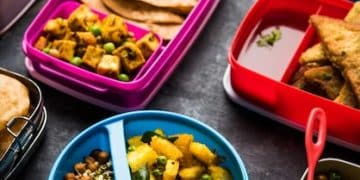How to Create a Flexible Meal Plan That Adapts to Your Schedule

Creating a flexible meal plan involves designing a weekly or monthly menu template that can be easily adjusted to accommodate unexpected changes in your schedule, dietary needs, or ingredient availability, ensuring you stay on track with your health goals without feeling restricted.
Do you often find yourself abandoning your meal plan because life gets in the way? Learning how to create a flexible meal plan that adapts to your changing schedule is key to maintaining healthy eating habits despite a busy lifestyle.
Understanding the Importance of Flexible Meal Planning
Flexible meal planning is about creating a framework rather than a rigid structure. It acknowledges that life is unpredictable and that your meal plan needs to accommodate those changes. This approach can significantly reduce food waste and help you stick to your health and wellness goals more consistently.
Why is flexibility so crucial? Here are a few reasons:
- Reduced Stress: Knowing you have backup options minimizes stress when unexpected events occur.
- Improved Adherence: A flexible plan is easier to stick to because it’s forgiving.
- Less Food Waste: You’re less likely to throw away unused ingredients because you can easily incorporate them into another meal.
Ultimately, flexible meal planning isn’t just about what you eat; it’s about building a sustainable and enjoyable relationship with food. It’s about adapting to change and making informed choices that support your health and lifestyle.

Assessing Your Current Schedule and Lifestyle
Before you begin crafting your flexible meal plan, take a good look at your typical week. Understanding your schedule and lifestyle is essential for creating a plan that actually works for you. Consider your work hours, commute times, social commitments, and any other regular activities.
Here are some questions to ask yourself:
What does your typical week look like?
Note down all your regular commitments, including work, school, family responsibilities, and social events. Identify days when you have more time to cook and days when you need quick and easy options.
What are your dietary needs and preferences?
Consider any allergies, intolerances, or dietary restrictions you may have. Also, think about the types of foods you enjoy eating and the meals you tend to gravitate towards.
Having a clear understanding of your schedule and preferences will allow you to build a meal plan that fits seamlessly into your life, rather than feeling like a chore.
Building a Foundation: Core Recipes and Ingredients
The key to a flexible meal plan is having a repertoire of core recipes and ingredients that you can mix and match. These are your go-to meals that are easy to prepare and can be adapted based on what you have on hand. Creating this foundation will help you stay on track even when your schedule gets hectic.
Consider these steps to build your core:
Identify 5-7 go-to meals:
These should be meals you enjoy making and eating and that can be prepared relatively quickly. Think about recipes that use versatile ingredients and can be easily modified.
Stock up on versatile ingredients:
Keep a pantry stocked with staples like grains, beans, canned tomatoes, onions, garlic, and spices. These ingredients can be used in a variety of dishes and are great to have on hand when you need to whip up a quick meal.
Master basic cooking techniques:
Knowing how to roast vegetables, grill chicken, or sauté tofu will empower you to create healthy and delicious meals with whatever ingredients you have available.

Implementing “Swap-In” Strategies for Meals
One of the most effective ways to add flexibility to your meal plan is to implement “swap-in” strategies. This involves identifying ingredients or components of a meal that can be easily substituted with alternatives based on what you have on hand or what’s on sale at the grocery store.
Here’s how to make it work:
- Protein Swaps: Chicken can be swapped for tofu, beans, or lentils.
- Vegetable Swaps: Broccoli can be switched out for spinach, zucchini, or bell peppers.
- Grain Swaps: Rice can be replaced with quinoa, couscous, or pasta.
By having these options in mind, you can quickly adapt your meal plan to fit your current circumstances. It’s also helpful to keep a list of potential swaps on your fridge or in your phone for easy reference.
Utilizing Theme Nights for Structure and Variety
Theme nights are a fun and effective way to add both structure and variety to your flexible meal plan. They provide a basic framework for your meals while still allowing you to experiment with different recipes and ingredients. Assigning a theme to each night of the week can simplify the decision-making process and make meal planning more enjoyable.
Here are some popular theme night ideas:
- Monday: Meatless Monday, focusing on vegetarian or vegan dishes.
- Tuesday: Taco Tuesday, featuring tacos, burritos, or other Mexican-inspired fare.
- Wednesday: Pasta Night, with a variety of pasta dishes.
- Thursday: Leftovers Night, using up any remaining food from earlier in the week.
The beauty of theme nights is that they are easily adaptable. You can adjust the theme to fit your preferences and dietary needs, and you can always swap out specific recipes based on what you have on hand.
The Power of Batch Cooking and Meal Prep
Batch cooking and meal prep are invaluable tools for creating a flexible meal plan. By dedicating a few hours each week to preparing components of your meals in advance, you can save time and effort during the week and ensure you always have healthy options available. This is especially helpful on busy days when you don’t have time to cook from scratch.
Here’s how to incorporate batch cooking and meal prep into your routine:
Choose a day for meal prep:
Pick a day when you have more free time to dedicate to cooking. This could be a Sunday, a day off, or even just a couple of hours in the evening.
Focus on versatile ingredients:
Prepare ingredients like roasted vegetables, cooked grains, and grilled chicken or tofu. These can be used in a variety of meals throughout the week.
Invest in good storage containers:
Proper storage is essential for keeping your meal prep fresh. Use airtight containers to store your cooked ingredients in the refrigerator and freezer.
Reviewing and Adjusting Your Meal Plan Regularly
A flexible meal plan isn’t a static document; it’s a living, breathing guide that should be reviewed and adjusted regularly. As your schedule, lifestyle, and preferences change, your meal plan should evolve to reflect those changes. Taking the time to review your plan will help you stay on track and ensure it continues to meet your needs.
When reviewing your meal plan, consider the following questions:
What worked well this week?
Identify the meals you enjoyed and that fit easily into your schedule. These are the recipes you should continue to incorporate into your plan.
What didn’t work so well?
Note any meals that were too time-consuming, didn’t taste good, or didn’t fit your dietary needs. These are the recipes you should consider removing or modifying.
Are there any changes in your schedule or lifestyle?
Adjust your meal plan to reflect any new commitments or changes in your routine. This could involve adding new recipes, modifying existing ones, or simply adjusting the timing of your meals.
| Key Point | Brief Description |
|---|---|
| 📅 Schedule Assessment | Understand your weekly commitments to plan meals accordingly. |
| 🥗 Core Recipes | Identify 5-7 go-to meals that are easy to prepare and adaptable. |
| 🔄 Swap-In Strategies | Use alternative ingredients based on availability and preferences. |
| ⏰ Batch Cooking | Prepare ingredients in advance to save time during the week. |
Frequently Asked Questions
▼
Focus on batch cooking and meal prepping on the weekends. Cook larger quantities of versatile ingredients like grains, proteins, and roasted vegetables, which can easily be mixed and matched throughout the week. Utilize leftovers creatively in new dishes.
▼
Keep a list of quick and easy meal options that require minimal preparation. Stock your pantry with staples like canned beans, pre-cooked grains, and frozen vegetables. Utilize simple recipes that can be adapted to whatever ingredients you have on hand.
▼
Incorporate theme nights into your meal plan to add variety. Experiment with different cuisines, spices, and cooking methods. Don’t be afraid to try new recipes and adapt them based on your preferences. Swap out ingredients to keep things interesting.
▼
Plan meals around ingredients that are already in your pantry and refrigerator. Utilize leftovers creatively in new dishes. Store food properly to extend its shelf life. Consider freezing excess ingredients or meals for future use. Compost food scraps to reduce waste.
▼
Aim to review your meal plan weekly to assess what worked well, what didn’t, and any new dietary needs or schedule changes. Adjust your plan accordingly to ensure it remains effective and enjoyable over time. Be open to trying new things.
Conclusion
By embracing the principles of flexible meal planning, you can create a sustainable and enjoyable approach to healthy eating that adapts to your ever-changing schedule. Remember to assess your lifestyle, build a foundation of core recipes, utilize swap-in strategies, and review your plan regularly. With a little planning and creativity, you can enjoy delicious and nutritious meals without feeling overwhelmed or restricted.





